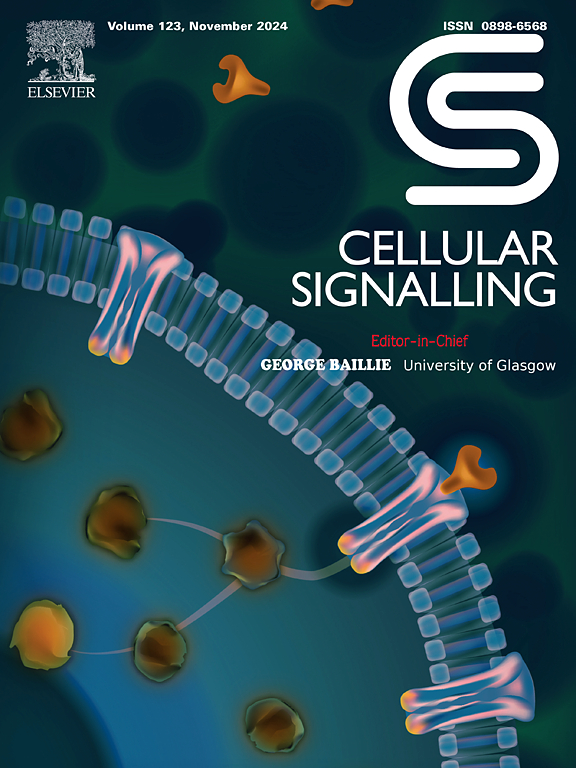水通道蛋白-5通过ROS/GSDMD途径促进肝切除术后肝脏再生。
IF 4.4
2区 生物学
Q2 CELL BIOLOGY
引用次数: 0
摘要
在肝脏再生的增殖阶段,对肝细胞过氧化氢(H2O2)过量产生的调节不足可导致氧化应激和肝细胞死亡。本研究旨在通过评价水通道蛋白5 (Aquaporin 5, Aqp5)在活性氧(reactive oxygen species, ROS)生成和nlrp3 - gsdmd介导的焦亡中的作用,探讨其对肝脏再生的影响。建立Aqp5-/-小鼠70%部分肝切除(PHx)模型,观察其肝脏病理变化。采用二氯二氢荧光素(DCFH-DA)测定法评估活性氧(ROS)的产生。Aqp5缺乏显著增加了活性氧的产生、tunel阳性细胞的数量以及Aqp5缺乏小鼠肝脏线粒体膜电位的破坏。通过给药n-乙酰- l-半胱氨酸(NAC,一种ROS清除剂)或双硫醚(DSF,一种GSDMD抑制剂)来检测Aqp5对ROS/NLRP3/Gasdermin-D (GSDMD)介导的焦亡的影响。在aqp5缺失小鼠中,再生肝脏表现出NLRP3表达增加,caspase-1和GSDMD激活增强,IL-1β分泌升高。DSF治疗可显著减轻再生肝中Aqp5缺乏引起的gsdmd介导的焦亡。此外,NAC对aqp5缺陷小鼠的处理导致NLRP3表达水平降低,caspase-1和GSDMD活性水平降低,IL-1β释放降低。我们的研究结果表明,Aqp5的缺乏通过ROS的产生促进了GSDMD的激活。抑制ROS或抑制GSDMD可显著减轻aqp5缺失再生肝的损伤和焦亡。本文章由计算机程序翻译,如有差异,请以英文原文为准。

Aquaporin-5 facilitates liver regeneration following hepatectomy via ROS/GSDMD pathway
During the proliferative phase of liver regeneration, insufficient regulation of hepatocyte hydrogen peroxide (H2O2) overproduction can result in oxidative stress and hepatocyte death. This study aims to investigate the influence of Aquaporin 5 (Aqp5) on liver regeneration by evaluating its role in reactive oxygen species (ROS) generation and NLRP3-GSDMD-mediated pyroptosis. A 70 % partial hepatectomy (PHx) model was established in Aqp5−/− mice to evaluate the pathological changes in the liver. Reactive oxygen species (ROS) production was assessed using a dichlorodihydrofluorescein diacetate (DCFH-DA) assay. Aqp5 deficiency significantly increased ROS production, the number of TUNEL-positive cells, and disrupted mitochondrial membrane potential in the liver of Aqp5-deficient mice. The impact of Aqp5 on ROS/NLRP3/Gasdermin-D (GSDMD)-mediated pyroptosis was examined through the administration of N-acetyl-L-cysteine (NAC, an ROS scavenger) or disulfiram (DSF, a GSDMD inhibitor). In Aqp5-deficient mice, the regenerative liver exhibited increased expression of NLRP3, enhanced activation of caspase-1 and GSDMD, as well as elevated secretion of IL-1β. Treatment with DSF significantly attenuated GSDMD-mediated pyroptosis triggered by Aqp5 deficiency in the regenerating liver. Furthermore, the administration of NAC to Aqp5-deficient mice resulted in a reduction in the expression levels of NLRP3, the activity levels of caspase-1 and GSDMD, as well as the release of IL-1β. Our findings indicate that the deficiency of Aqp5 facilitates GSDMD activation through the production of ROS. The suppression of ROS or inhibition of GSDMD significantly alleviates the damage and pyroptosis observed in Aqp5-deficient regenerative liver.
求助全文
通过发布文献求助,成功后即可免费获取论文全文。
去求助
来源期刊

Cellular signalling
生物-细胞生物学
CiteScore
8.40
自引率
0.00%
发文量
250
审稿时长
27 days
期刊介绍:
Cellular Signalling publishes original research describing fundamental and clinical findings on the mechanisms, actions and structural components of cellular signalling systems in vitro and in vivo.
Cellular Signalling aims at full length research papers defining signalling systems ranging from microorganisms to cells, tissues and higher organisms.
 求助内容:
求助内容: 应助结果提醒方式:
应助结果提醒方式:


